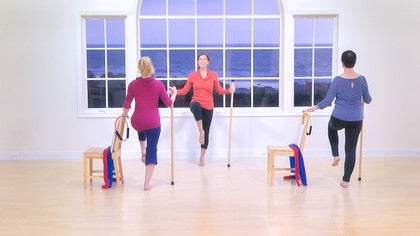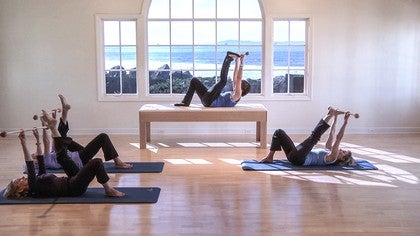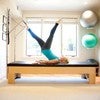Description
About This Video
Transcript
Read Full Transcript
Hi, I'm Mariska Breland and I'm here to talk a little bit about balance. Today. Balance is something that cannot be covered in a brief tutorial. It's a huge topic. Um, in my plots for ms course, it covers about four hours and today we're going to try to condense some of the principles of it into about 20 minutes. So first thing is balance is just the ability to maintain your position over a base of support. So right now my base of support are my feet and legs. I'm standing if I was kneeling on the reformer, that's a different base of support if I'm in a quadruple position.
That's another base of support. Seated is also a base of support and that's something that you often look at with um, elderly clients. Maybe if you have neurological clients, whether they can actually maintain their balance. Seated is something that's actually really important. Statistically, it's really interesting because one out of three adults over the age of 65 are going to fall every year and of those falls. Um, the number one cause of fatal and nonfatal injuries in people over 65 is falls. Once somebody has fallen, they're going to have a real fear of falling again, in which case they developed some really interesting compensations, a lot of which are not useful or beneficial to them. You'll find people will start to take really small steps and if you ever try to walk and take small steps, it's actually going to be a lot more difficult than if you walk with a normal stride. You can also have people have, um, balanced challenges because they're moving away from pain.
And this is something you see a lot. So if somebody has, for instance, a painful ankle, knee or hip, they're going to sort of list towards the other side because they're trying to keep away from that painful side, in which case they're going to throw themselves off of balance. So one of my main interests as a teacher is working with neurological conditions and really understanding how the brain plays a role in these, um, different things such as balance and in terms of balance. You're getting input from your environment, from your body all of the time, and it's coming in through first your visual sense. Um, which actually in terms of balances the weakest sense. So if somebody is really relying on their vision for balance, that's actually not a great thing because that's going to be the most easily upset with things like perturbations, which would be like if you're knocked off balance your vision, um, has to kind of reestablish where you are in space. Secondly, you have the appropriate septic systems, so your appropriate sectors are your ability to know where you are in space. And there are also, um, things that respond for instance, to stretch.
So if I lean forward, I'm getting the signal to my brain on my appropriate sectors and my feet that there's more pressure so that I need to stabilize by making some sort of adjustment. Finally, you have your vestibular sense. So your vistibular senses your inner ear and it's three canals that basically are filled with liquid. So if you turn your head in one direction, the in your inner ear canal is going to sort of flow to one side or it might, you know, come back to the other side. And this is really helping you with positional changes. And especially head movements. Um, if somebody has a vestibular balance problem, they will probably describe it as they're dizzy a lot, or they feel like they're drunk or that the earth is moving or they're rocking or something like that. Visual stuff you'll obviously know because they'll probably tell you if they have a visual problem, appropriate deceptive problems.
A lot of times people don't know they have. So this is something that you can test for, and we'll talk about that in a second, how to do it. Other things that are gonna impact balance are going to be muscle strength and muscle imbalances. So if somebody, for instance, has really weak hips and they're trying to stand on one leg and they dip into their hip a lot because their glute meat isn't strong enough to hold them up, that's something that's gonna impact balance, ankle imbalances and ankle flexibility problems. So if somebody can't stretch their calf enough to really take a step forward and keep their calf down and maintain their balance with that, that can be a problem. Can also be problems, again, with flexibility and pain. So I'm going to bring 'em Kaita in. So k two is my Guinea pig today cause I want to start talking about, um, some things you can do to assess people's balance. So probably the most, um, simple thing is to just use a chair.
I'm gonna have you have a seat in this lovely chair that matches perfectly it's environment. So first thing I actually want to test, um, proprioception. So again, appropriate assumption is the ability to know where you are in space. So I want you to not looking at your legs, take your right heel and drag it up to your left knee. So just slide your heel on your shin and then lower it back down and then you're going to go to the other side. So opposite light comes in and actually wants you to bring your heel forward on your leg. Good. And then you just pull it up and lower it back down.
And so what you're looking for here and can keep going is whether she can do this without her leg, kind of shimmying all around. She really knows where her leg is in space. And this is, um, something, if you go to a neurologist and never have to get tested by a neurologist, you'll probably get this test to see how your appropriate assumption is. So if for instance, she came in and she was, um, do it like crazy like that, you can't figure out, like if she was doing something like this, then I would say, okay, we're going to probably need to work on her proprioception, okay, feet down. And then the next one you're going to do is sit to stand. Sit to stand is a really, um, key diagnostic tool because it points out a lot of weaknesses of which I'm sure k two doesn't have. But go ahead and come up to standing.
So she came to standing and then sit back down and then we're going to do that. So we'll come to standing. There's the train making its appearance. We're gonna come back up to standing and then sit back down. Now let's say Kaita didn't have good balance. One of her compensatory things that she would do most likely.
And you wouldn't necessarily, you know, need to cue this. You would just want to see if it happens is she would hold the chair while she was coming up. So she might come sit to stand and hold the chair to like give herself a little assist up. And especially on the way down she might be looking back to make sure the chairs there cause she was nervous that she might fall. Okay. So on the next one, let's go ahead and come up to standing and then we're going to do a little test called the Romberg test.
We're just going to have you reach your arms forward and then I would stand near her just to make sure she, if she does have bad balance, if she feels like she's going to fall, I want you to first lengthen your lower back a little bit. Good, grow taller and then shut your eyes. So what you want to look for and she has really great proprioception cause she has like no sway at all but if she started to sway back and forth. So if you want to like move back a little bit and forth, like if there was a big sway like this and go ahead and open your eyes, then you would know that the appropriate sectors in her feet weren't kicking in properly. Okay. So another thing that you could look for is if somebody is doing the stand to sit and they sort of plopped down. So if you can sit not so gracefully as you normally would and they sort of plopped down like that, it could indicate a couple of things. First, it could indicate a lot of weakness in the hamstrings and glutes, but it can also, um, have that somebody is in pain.
So if they have more pain, they're going to sit down a little bit less gracefully. Okay. So come up one more time. So come sit to sand. Nice. Um, one other thing I, I neglected to mention is when you're watching people, if their knees knockin when they're standing up, there's probably either tightness or a muscle imbalance that's coming from the inner thighs in terms of the outer thighs. So just look, look for things like that. Whether the knees go out or in. So I'm gonna take her into something called the tandem stance, which normally is another exercise done in neurological exam. So you're gonna bring your heel in line with your toes of your opposite foot. So this actually sets you really off balance because we've just taken, um, and made something more of a balance challenge by making your base of support smaller. So for her, it looks like to me that your weight is back in your back foot entirely.
So I want you to balance it out, right so that you're moving your weight evenly. So how does that feel different? Do you feel a little more wobbly? Right? So you're gonna feel more wobbly if you're in the support of both legs. So normally in a neurological exam you would actually have the heel to toe walk, like a drunk driver test. But, um, here you're just looking for how people are balancing everything out and then go ahead and return back and then you would do the other leg. So sometimes when people aren't standing evenly between their two legs, that can be another indication that there's pain. Especially like in an ankle, that they're just going to favor one side over another and then go ahead and come back to center. And then I would do one. Um, now we're going to talk a little bit about a couple of different strategies.
People have to keep their balance in. A great way to see it is for her to stand on one leg. So just lift a leg up, pick a leg, your favorite leg. So the first thing that's going to happen for her to maintain her balance is something called the ankle strategy. So she has good balance in her ankle. You can see if you look at it that her foot is either hurting and inverting the tiniest little bit.
You'll see all the little muscles in her foot and her ankles start to work, especially if I know she's a dancer, so she can do this. Go ahead and extend that leg forward and then take your leg out to the side towards me. So she just began to initiate a little bit of the hip strategy, which is the second place that's going to come into play, which is that she's going to maneuver her hip a little bit to maintain her balance in that position. And then you can come back to standing and then let's say she was standing on one leg and then she was a little bit wobbly. So we know maybe her ankles a little bit wildly and her hips getting a little bit wobbly. And let's say there was some sort of, um, outside force what she just did with something called the step strategy.
So the final keeper of balance and in that test is that you would step out of it to just reestablish a bigger base of support and make yourself, you know, not fall down, which is important. But, um, sometimes if people have really poor balance, their step strategy is wrong and then they'll fall away from the direction they should be stepping. So you would want to look to see, you know, if she's stepping in the right direction. Okay. So another way to look at strength and balances. I want you to stand up with your right leg a little bit forward and your left leg a little bit back. So go ahead and press up. So this time she would press up and it will be more with her left leg that she's pressing up. And then go ahead and sit it back down in the chair. Moved a little bit good. And again, so we'll stand up once on the side and sit it back down. And looking at her, my guess is that she doesn't stand up like this. Normally switch legs.
So people are, you know, always one side dominant and so she's probably right side dominant and likes to stand up with her right leg and people are gonna stand up with their strong leg back. And if somebody has a weakness, especially if they have a neurological weakness and you're trying to reprogram in movement, that might be a little bit more therapeutic for them, then you would ask them to stand up with their opposite, their strong leg forward instead of back. And you can watch that. You'll, you can see that the hips will be a little bit less cooperative when you're doing the side that isn't as strong.
One's called Tinetti and one's called Berg. Some of these exercises are in there. I want to do one other one that can show more of a dynamic um, motion. And so we're going to grab the moon box and we're going to have as if this was a step and you could use this step if you have steps, I'm just going to have you step up one foot to the box and then back. But you're not going to actually stand on it.
You can even just tap your toes to it. So your tap and back and tap and back. And so what I want to look at here is how much are her hips moving side to side? Like is she dipping into her hip when she's moving? Cause that would show, let's say you dip into your hip. So let's, that makes me think that this glute need and these muscles need to be strengthened so that she can be a little bit more even when she's stuffing. And then also can she do it quickly?
So how fast can not speed adjust. Because when you're walking on the floor, your body has to make all these tiny micro adjustments all of the time because every step you take is going to be slightly different from the last step that you took. Okay? You can go ahead and stop. So do three exercises that would sort of address a couple of the different problems that we might have. And the first one, I want you to grab the magic circle and then have a seat in the chair and you're gonna step through the magic circle so that the little pads of the magic circle come right above your knees. And let's say she was getting up and we had seen maybe her knees were knocking together as she was standing up. And we want to work on her being able to be more stable and really standing into, um, her feet and engaging her outer hips. So go ahead. From there, you can reach your arms forward and then you're going to come up to standing, keeping equal pressure on the circle and then lower down, coming back down
And you can pull your ribs back a little bit so you can, you know, throw some plots in there and adjust people's posture and making sure that you have the pressure out. So does it feel different from how you would normally stand up? Yeah. Yeah cause he was firing a little bit more into the outside. So I actually liked the magic circle too with bridging with anything that you want to give a little bit more feedback if that's an area you want to strengthen. So I will take that. And we talked about the ankle being the primary keeper of balance.
And so a couple of just different ankle exercises. First we're going to use the therabands your theraband. I want you to wrap it around your feet, sort of tie them together. So step over them and then just wrap it around a couple of times. Yeah. Just so you basically perfect.
And then you're gonna hold on to either side and pull them away from each other. Nice. And then keeping your feet along the floor, you're going to slide your feet open so you're engaging the everters of your foot and then pull it back to center. And you just have to be careful that this doesn't come off. And if she's trying, if it's um, coming off a little bit too much, she can ever lift her feet up, lift your toes off a little bit. Yeah. And then pull back in. So where do you feel that feel it is? Yeah. So in the perennials, which I understand are being renamed. Yeah. And just make sure that it doesn't fall off to keep up the Palladio's world and all the physical therapists guessing they're changing the name of the perennials to the fibular as longest or something.
I don't know. But that is the muscle that we're trying to target. Have your feet reaching forward and we're going to actually make sure that the foam roller is below her knees. So lengthen your feet. And then we're just going to squeeze in Switzerland. Isometric, hold in towards the foam roller and then release. And I symmetric, squeezed in Nice and release. So you could do like an isometric squeeze and hold for a count of 10, two, three, four, five, six, seven, eight, nine, 10 and release. And so this is working that the muscles that invert the foot.
And so you can sometimes see that the muscle will be different. Like sometimes you would need to work the everters and not the inverters, the inverters, not the inverters, but sometimes there's just an overall ankle weakness and you would want to work the ankle a little bit and there's dozens of exercises that you could do. Um, but these are some easy ones with just some props that you probably have around the studio or the house you are done. Thank you very much.
Active Aging: Improving Balance
Comments

You need to be a subscriber to post a comment.
Please Log In or Create an Account to start your free trial.

























